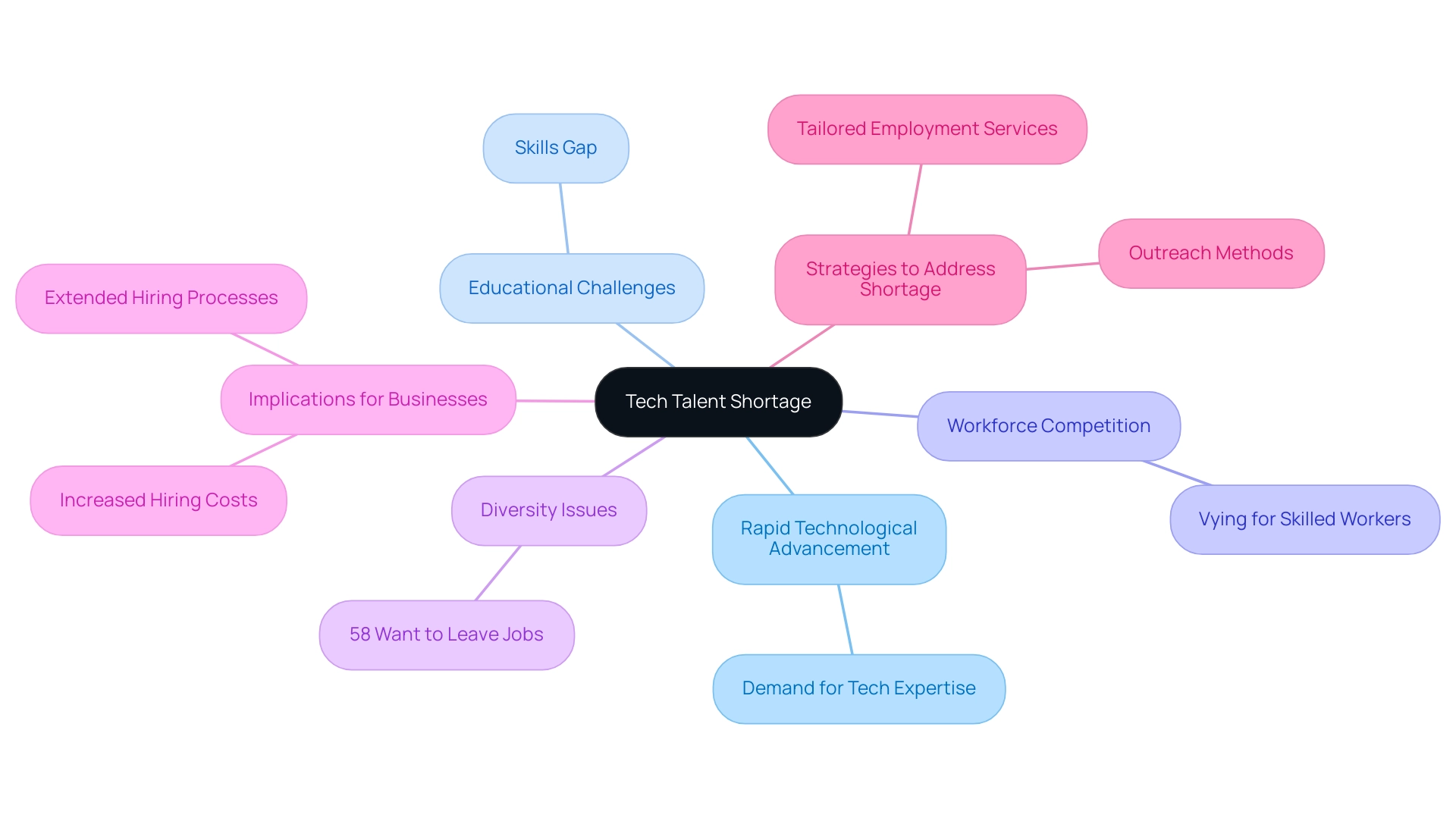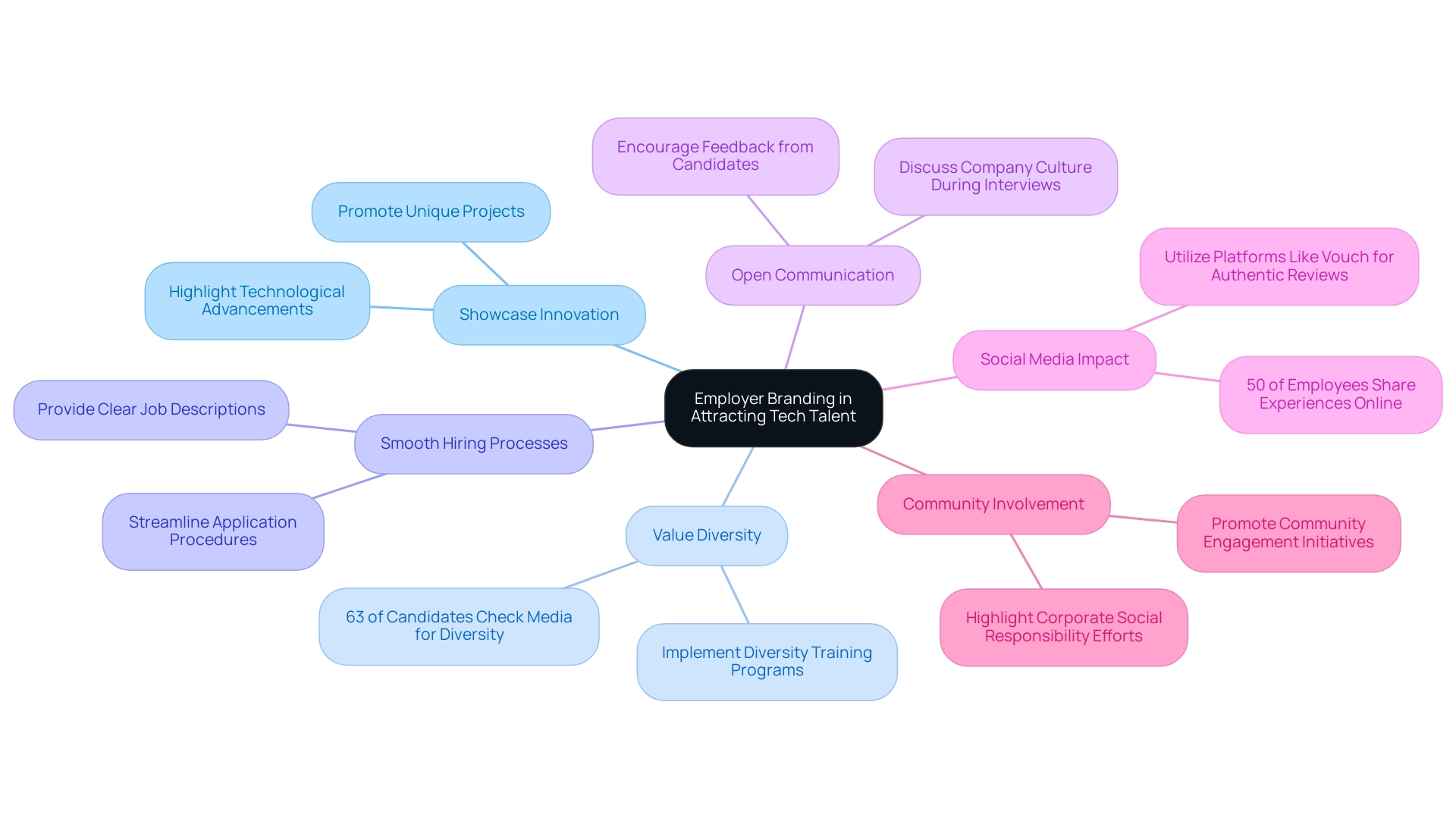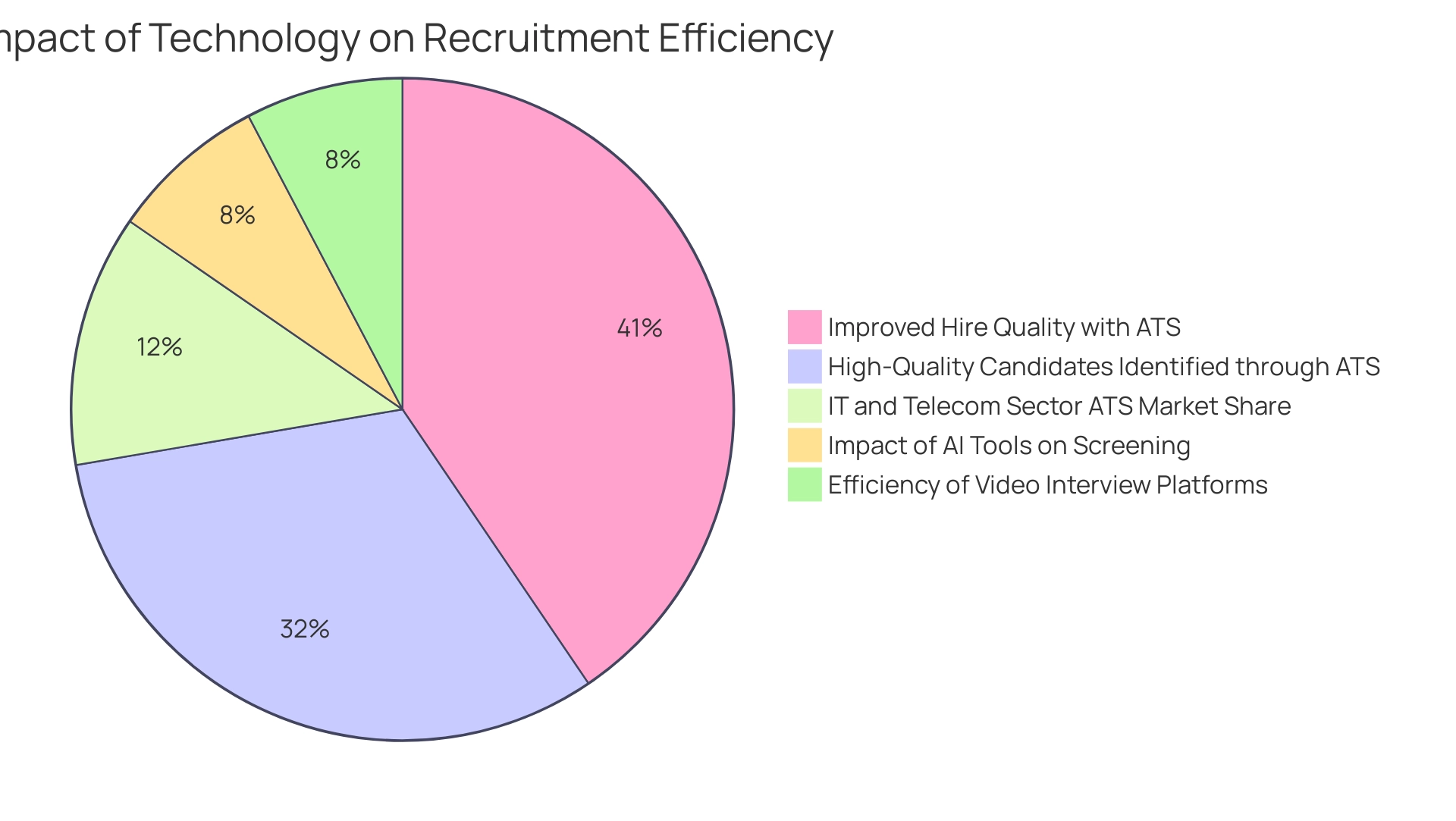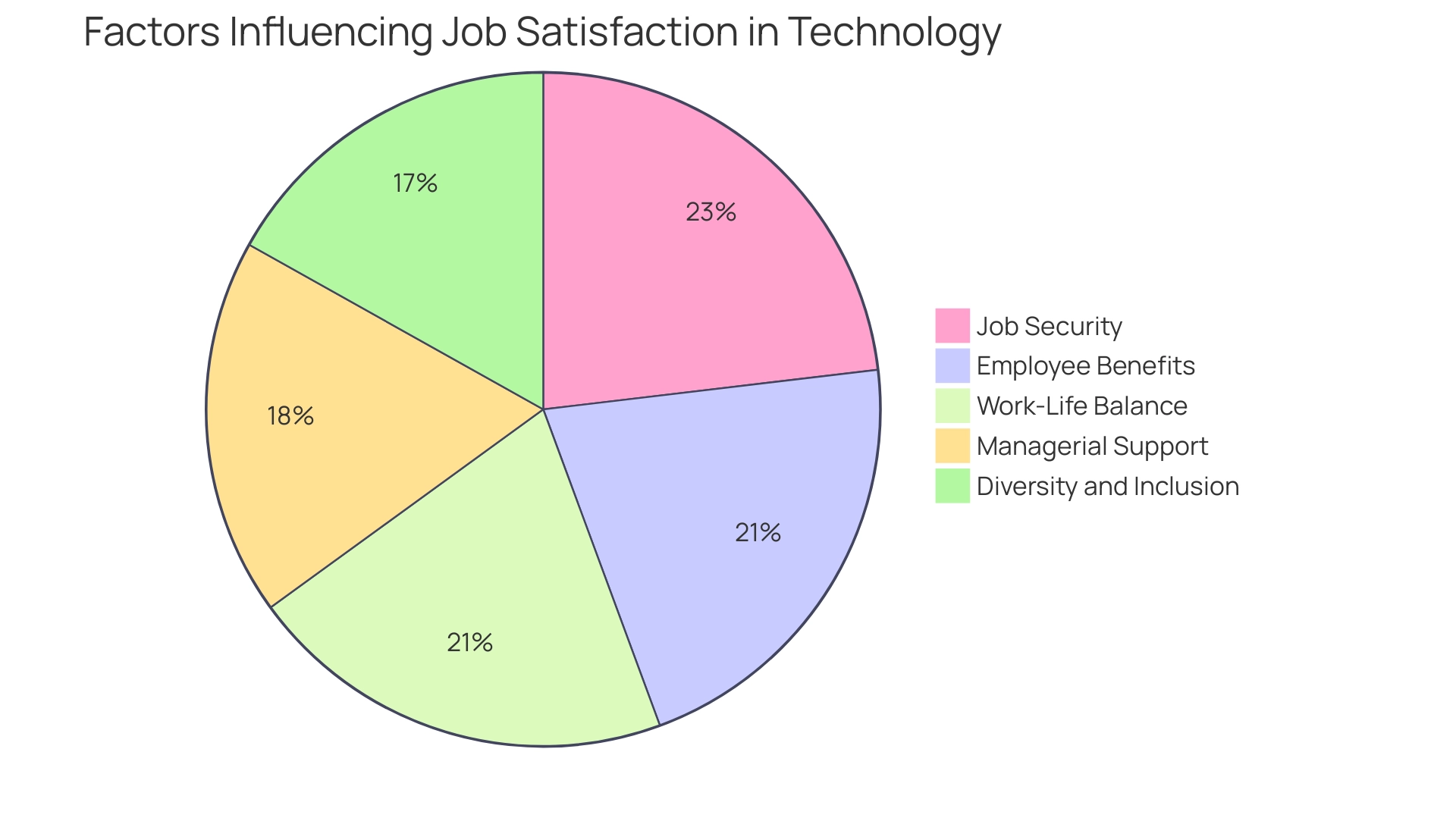Overview
The article outlines ten effective solutions to address the tech talent shortage, primarily focusing on strategies such as investing in training programs, enhancing employer branding, and fostering diversity within recruitment efforts. These solutions are supported by evidence showing that educational partnerships, targeted recruitment, and continuous learning initiatives can significantly bridge the skills gap and improve hiring outcomes in a competitive job market.
Key Highlights:
- The tech talent shortage arises from rapid technological advancements outpacing the availability of skilled professionals.
- Educational institutions struggle to update curricula, leading to a skills gap among graduates.
- Diversity issues exacerbate the talent shortage, with many underrepresented individuals feeling out of place in the workplace.
- Companies face increased hiring costs and delays due to the competitive job market for tech talent.
- Investment in training programs is essential for improving the skills of current employees.
- Building relationships with educational institutions helps ensure that graduates are equipped with relevant skills.
- Implementing new sourcing strategies, including AI tools and media outreach, can enhance recruitment efficiency.
- Establishing a strong employer brand is vital for attracting top talent, emphasizing company culture, and career opportunities.
- Creating a diverse talent pipeline through targeted recruitment initiatives can address the shortage effectively.
- Ongoing learning and development opportunities are crucial for employee retention and satisfaction.
- Engaging with the tech community through events and sponsorships enhances visibility and credibility in the job market.
Introduction
The technology sector is facing a lack of skilled workers at the moment, which is causing concerns for businesses in different industries. As advancements in technology happen rapidly, the need for qualified professionals exceeds the available workforce capacity by a significant margin, leading companies to struggle to find suitable candidates for key positions.
This piece examines the reasons contributing to this shortage, such as:
- Educational disparities
- The competitive job market
It also suggests practical approaches that organizations can adopt to draw in and keep talented individuals on board.
To tackle the intricacies of this matter and implement hiring strategies effectively can help businesses not just overcome present obstacles but also set themselves up for prosperity in an ever-changing digital landscape.
Understanding the Tech Talent Shortage: Causes and Implications
The shortage of technology talent is mainly due to a combination of factors that are intertwined with each other. The rapid advancement in technology has far exceeded the number of professionals available in the market today. This has led to a demand for tech expertise across various industries as organisations are shifting towards digital solutions.
Moreover, educational institutions are facing challenges in updating their course offerings to align with the changing needs of the industry. This results in a gap in skills where graduates often lack the competencies. The current situation is made worse by a growing environment where companies are vying for a small pool of skilled workers with great fervour.
Enough 58 percent of Hispanic or Latino individuals expressed a desire to quit their jobs due to feeling out of place because of their background, emphasising the challenges related to diversity that worsen the scarcity of talent. As a result, this scarcity has consequences for businesses, leading to increased hiring costs, extended hiring processes, and possible setbacks in project schedules. Smaller hiring agencies provide tailored employment services that are crucial in navigating the competitive job market landscape today and are especially valuable for positions like Chief Technology Officer (CTO), Engineer, and HR Director.
To highlight this point further, Vice President of North America Ted Donnelly stresses the idea of becoming a supplement to their clients’ IT teams rather than a substitute, emphasising the significance of personalised hiring tactics. These agencies utilise approaches such as outreach and competency evaluations to guarantee a successful alignment between candidates and the requirements of the organisation. One illustration provided by a life sciences firm showcases this strategy; they emphasise speed and skill when hiring technology professionals by involving specialised recruiters as the initial contact in the process.
This approach is crucial for attracting industry experts, especially in traditional sectors aiming to enhance their pool of skilled individuals. Ultimately, ongoing challenges may damage effectiveness and hinder creativity, highlighting the importance of implementing strategic methods such as customised hiring solutions as tech talent shortage solutions to address the shortage of skilled workers in the technology sector. Feel free to reach out to us if you’d like to know more about how we can help you tackle these obstacles.
Effective Strategies to Mitigate the Tech Talent Shortage
To effectively address the shortage of skilled tech workers, organisations can implement various tech talent shortage solutions.
Investment in training programmes is crucial for improving the abilities of current staff to keep them competitive in the ever changing technology sector. It’s worth noting a significant 101% rise in resilience skills development annually highlights the importance of these investments. Platforms such as Deel Engage offer career structures and training resources along with feedback systems to support this skills enhancement effort.
Broadening the skill base can be accomplished by offering job opportunities to staff from diverse locations worldwide to improve hiring strategies and encourage a more adaptable work environment.
Enhancing our hiring practices is crucial for success in staffing initiatives. The aim is to employ and provide applicants a favourable experience to attract the best individuals effectively. Boutique hiring firms differentiate themselves by providing solutions that address each organisation’s unique needs and ensure a seamless interviewing process.
Establishing an employer brand is essential for attracting exceptional individuals to your organisation. Ensure you emphasise your company’s culture, career advancement opportunities, and values to attract candidates.
-
Establish Strong Relationships with Educational Institutions:
Building connections with colleges and vocational schools is crucial for ensuring that academic programmes meet the demands of the industry effectively. According to a study by the World Economic Forum mentioned in a report, trending skills like critical thinking, effective communication, and adaptability are highly valued by employers nowadays. This cooperation helps to prepare a pool of graduates who are well equipped to kickstart their careers.
-
Employing New Sourcing Strategies:
Involves using cutting-edge methods for hiring, such as leveraging media for employment and utilising AI-powered tools, which can enhance the efficiency of identifying suitable candidates significantly. Smaller recruiting agencies frequently use these approaches effectively in linking customers with high quality candidates spanning industries.
In today’s job market, it is essential to offer appealing salary and benefits packages to attract and retain top professionals.
Creating a workplace that values diversity and inclusion involves adopting a recruitment approach that attracts candidates from backgrounds enhancing the pool of talent and fostering innovation within the workforce.
-
Hiring Freelancers and Contractors:
Bringing in freelancers or contractors to fill tech positions can offer flexibility and quick assistance to meet project needs promptly.
Fostering a Positive Candidate Journey involves enhancing the experience of candidates, from the moment they apply to when they join the team to boost retention rates and draw in referrals according to HR professionals who stress that acknowledging achievements is an effective, often neglected way to boost organisational success. This approach can significantly impact how candidates perceive your organisation overall.
Alongside that point, there has been a surge in leaders directing resources towards enhancing their coaching skills by a substantial 177%, demonstrating how vital leadership development is in addressing the shortage of skilled individuals.
By using these tactics and taking advantage of the specialised search features provided by small recruiting agencies, organisations can effectively implement tech talent shortage solutions to overcome the challenges posed by shortages of skilled workers in the tech industry. This personalised method is particularly advantageous for positions like Chief Technology Officer and Engineer. Get in touch with us to discover how our personalised hiring solutions can contribute to creating a workforce.
The Role of Employer Branding in Attracting Tech Talent
In the business realm where competition is intense in the technology sector, establishing a strong employer brand is vital to attracting top-tier professionals. The exceptional candidates are not just interested in any job; they carefully select opportunities that align with their values and aspirations. To succeed in this battle, talented organisations must showcase what sets them apart—like promoting innovation and valuing diversity.
Guarantee that their hiring procedures are smooth and polished. During interviews, job seekers are carefully evaluating organisations to spot any warning signs that suggest differences in their expectations might arise. To prevent these signals from emerging, hiring managers should openly discuss the organisation’s culture.
Provide detailed information about the position while having meaningful conversations with candidates about their career goals. Research indicates that 63% of candidates review media to evaluate an organisation’s commitment to diversity in the workplace, emphasising the significance of being honest and genuine in branding initiatives. Additionally, research shows that half of employees often share their work experiences on their social media profiles, which can have a big impact on attracting new talent to an organisation.
Through platforms like Vouch that allow for the creation of video content showcasing real employee stories, a business can improve its reputation as an employer. Furthermore, promoting successes and involvement in the community can strengthen how the brand is perceived. However, a mere 12 percent of businesses actually assess the influence of their employer image, suggesting room for improvement in this area.
By concentrating on developing an employer reputation and employing targeted strategies to avoid potential interview pitfalls while improving the efficiency of the hiring process, organisations can utilise tech talent shortage solutions to strengthen their capability to attract and retain top-tier technology professionals essential for achieving their objectives.
Leveraging Technology for Recruitment Efficiency
In the business landscape, companies can greatly improve their hiring processes for in-demand finance and tech positions like CFO and Financial Manager by using various advanced technologies. Applicant Tracking Systems (ATS) are key in simplifying the application process, allowing recruiters to handle candidate information accurately. Current data indicates that 79% of recruiters observe better quality hires with ATS usage, emphasizing its effectiveness in enhancing hiring outcomes.
Moreover, talent teams sourcing through an Applicant Tracking System (ATS) discover that 62% of them identify high-quality candidates compared to those from inbound applications, highlighting the benefits of leveraging this technology. Additionally, AI-powered tools play a role in screening resumes by helping to pinpoint top candidates based on finance and technology-related criteria.
The influence of intelligence on the hiring process is significant, with continuous enhancements in AI tools expected to enhance hiring effectiveness by 2024. Using video interview platforms allows for conducting interviews efficiently and effectively to save time and resources while keeping candidates engaged throughout the hiring process. For example, companies that enhance their job postings for Applicant Tracking Systems by using concise language and appropriate keywords have experienced increased visibility and interest from candidates.
As highlighted in a study called ‘Enhancing Job Postings for Applicant Tracking Systems’, personalized job descriptions featuring qualifications and easy-to-follow application guidelines greatly improve outcomes within an Applicant Tracking System. By incorporating these advancements into their operations, financial institutions can streamline their hiring procedures and implement tech talent shortage solutions while also improving the job applicant experience. This makes it simpler for top-tier professionals like Chief Financial Officers and Financial Managers to establish connections within the organization.
It is worth noting that the Information Technology and Telecommunications sector commands a 24% share in the Applicant Tracking System market, underscoring the significance of these tools in different sectors and their potential impact on providing tech talent shortage solutions for skilled workers. Specialized hiring tactics can enhance this method by tailoring campaigns to appeal to highly skilled individuals for these pivotal positions.
Building a Diverse Talent Pipeline
To tackle the tech talent shortage solutions effectively, organisations must concentrate on creating a diverse pool of skills through targeted recruitment initiatives with underrepresented groups and partnerships with diversity-focused organisations in the field. There is a growing need for companies to take action toward equality as indicated by recent data showing that 71% of black employees believe their employers should do more in this regard. Introducing mentorship programmes and structured internship opportunities can make career paths in technology more appealing to a range of candidates while providing them with essential support to succeed.
In the technology industry, job satisfaction is heavily influenced by factors like:
- Job security (74%)
- Employee benefits (68%)
- Work-life balance (66%)
- Managerial support (58%)
- Diversity and inclusion (54%)
It’s crucial to recognise the significance of initiatives in fostering a positive work environment. As correctly noted by Nabila Salem from Revolent; “Let’s work together to tackle gender equality, in technology!”
By establishing a work environment and effectively addressing common hiring obstacles like disorganisation and vague communication, businesses can implement tech talent shortage solutions to broaden their talent pool and encourage innovation, resulting in improved business outcomes. Furthermore, adopting technology to support a flexible work model is essential in enhancing recruitment strategies that attract diverse candidates and serve as effective tech talent shortage solutions. The 2021 D&D ranking highlights Zoom’s role in advancing diversity initiatives and illustrates the impact of such rankings on hiring methods and industry standard-setting practices as we progress toward 2024 and beyond.
Continuous Learning and Development Opportunities
To ensure that technology staff remain involved and advance within an organisation’s hierarchy effectively, it is essential for businesses to emphasise providing ongoing educational opportunities and paths for personal growth. Deloitte pointed out that 55 percent of CEOs pinpoint the cultivation of leaders as a key hurdle to address, underscoring the importance of investing in employee growth and advancement programmes. This strategy can involve a range of approaches such as:
- In-depth training sessions
- Workshops
- Easy access to online courses
All aimed at empowering staff to hone their abilities and stay up to date with the latest industry advancements.
For example, endeavours like coding boot camps and specific certifications in technologies have shown to be effective in improving the skills of tech workers. We can also enhance development and industry connections by attending tech conferences and networking events. It is crucial for organisations to measure the return on investment of employee training by using performance metrics and feedback surveys to evaluate the impact of these programmes.
Studies have shown that leadership training can boost learning capability by 25% and performance by 20%. Investment in employee growth benefits organisations by enhancing employee happiness and loyalty, while also addressing tech talent shortage solutions to empower their technology teams to maintain competitiveness and contribute to advancements within the organisation’s operations. With the training sector anticipated to yield $14.2 billion in revenue by 2023, the emphasis on continuous education is poised for growth, establishing it as a critical approach in the technology industry for 2024 and beyond.
Engaging with the Tech Community
Getting involved with the technology community is a strategic move for organisations seeking tech talent shortage solutions to attract top-notch talent. Particularly in desirable areas such as finance and technology that demand experts like Chief Technology Officers (CTOs), Engineers, and HR Directors. Sponsoring gatherings or hackathons and organising coding competitions can significantly enhance an organisation’s visibility in this intensely competitive sector.
Boutique Recruiting specialises in developing recruitment strategies that address the unique needs of firms across various industries and provides customised searches for key roles. A recent research study including 845 C Suite executives and 1920 HR leaders along with 9449 employees and 84 investors has shown that 62 percent of workers feel they are more productive when working from home; however a worrying 69 percent admit to experiencing burnout as well. This emphasises the importance of fostering relationships within the workplace—a key factor that technology professionals prioritise for job satisfaction and retention purposes.
Engaging with individuals in the technology sector not only enhances credibility but also positions the organisation as an active participant in shaping the industry’s future. According to Susan Cantrell from Deloitte Consulting LLP’s Products department, engaging with the technology community is essential for companies to align talent acquisition with the evolving technology job market, and implementing tech talent shortage solutions by demonstrating a dedication to innovation and impactful projects can leave a lasting impression on potential hires. Moreover, collaborating with communities provides information on industry trends and new technologies that can shape recruitment tactics directly.
For example, traditional car manufacturers use their known status to recruit employees by highlighting their innovation initiatives and positive influence on society to appeal to tech professionals searching for fulfilling opportunities. If you are interested in discovering how Boutique Recruiting can support your customised hiring requirements, please reach out to us at your convenience.
Conclusion
The persistent lack of qualified tech professionals poses an obstacle for companies in different sectors today. With technological progress surpassing educational advancements and tough competition for a limited talent pool alongside the demand for greater diversity and inclusion adding to the issue, businesses are facing rising recruitment expenses and prolonged hiring procedures that could impede efficiency and creative breakthroughs.
In order to address this challenge efficiently and effectively, businesses need to implement initiatives such as:
- Investing in educational programmes
- Improving hiring procedures
- Boosting their reputation as employers
By prioritising an interaction with candidates and establishing connections with schools and universities, companies can align their recruitment strategies more closely with the demands of the job market. The integration of tools like Applicant Tracking Systems and AI-supported technologies also plays a role in optimising the recruitment process while enhancing the calibre of potential hires.
Furthermore, creating a pool of skilled individuals and providing ongoing educational chances are crucial for drawing in and keeping top-notch employees. Getting involved with the technology community by sponsoring events can also boost a company’s prominence and attractiveness to applicants.
To sum up, the discussion on tackling the shortage of tech talent effectively involves a strategy that considers both short-term hiring requirements and long-range workforce enhancement efforts. By adopting these approaches and plans of action, companies can not only address present obstacles but also prepare themselves for continued prosperity in a changing digital environment. Prioritising talent acquisition today equates to securing the growth and success of the organisation.
Frequently Asked Questions
What factors contribute to the shortage of technology talent?
The shortage of technology talent is primarily due to the rapid advancement in technology outpacing the number of available professionals, a gap in skills among graduates due to outdated educational offerings, and intense competition among companies for a small pool of skilled workers.
How does the lack of diversity affect the technology talent shortage?
A significant percentage of Hispanic or Latino individuals express a desire to leave their jobs due to feeling out of place, highlighting challenges related to diversity that exacerbate the talent scarcity.
What are the consequences of the technology talent shortage for businesses?
The talent shortage leads to increased hiring costs, extended hiring processes, and potential delays in project timelines.
How can smaller hiring agencies assist in the current job market?
Smaller hiring agencies provide tailored employment services that help navigate the competitive job market, particularly for high-demand positions like Chief Technology Officer, Engineer, and HR Director.
What strategies can organizations implement to address the shortage of skilled tech workers?
Organizations can invest in training programs, broaden their hiring strategies to include diverse talent, enhance hiring practices, establish a strong employer brand, and build relationships with educational institutions.
Why is it important to establish relationships with educational institutions?
Collaborating with colleges and vocational schools ensures that academic programs align with industry demands, preparing graduates with the necessary skills for their careers.
What new sourcing strategies can enhance hiring efficiency?
Utilizing media for employment and AI-powered tools can significantly improve the process of identifying suitable candidates.
How can companies create a more appealing workplace for tech professionals?
Offering competitive salary and benefits packages, fostering a workplace that values diversity and inclusion, and enhancing the candidate experience can attract and retain top professionals.
What is the benefit of hiring freelancers and contractors in tech roles?
Hiring freelancers or contractors provides flexibility and quick assistance to meet project needs promptly.
How can organizations improve the candidate journey?
By enhancing the experience from application to onboarding, acknowledging achievements, and focusing on leadership development, organizations can boost retention rates and attract referrals.






